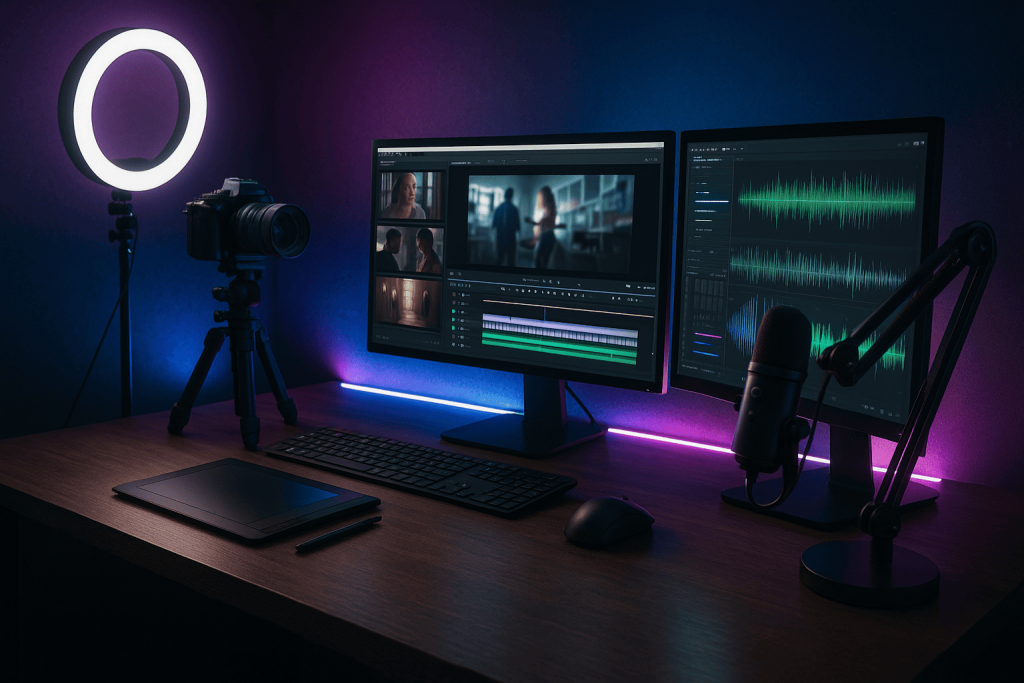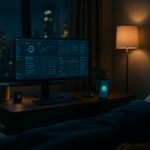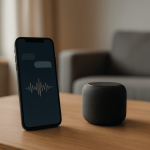Synthetic media turns text, images, audio, and small datasets into finished videos, podcasts, trailers, courses, and ads—on demand. With the right stack, a single creator can operate like a full production house: writing, directing, shooting (virtually), editing, localizing, and shipping content at scale. This guide shows how to design that studio, end-to-end, with practical workflows, prompt patterns, guardrails, and automation tips.
What a “Synthetic Media Studio” Actually Is
Think of a synthetic studio as a pipeline, not a tool. Inputs are briefs, brand assets, references, and data. The pipeline runs through ideation, scripting, design, voice, visuals, assembly, quality control, and distribution—each step accelerated by AI. The output is not just a video; it’s a reusable system that can generate variants, formats, and languages with minimal extra work.
Design Your Core Stack
Strategy & knowledge layer. Use an AI assistant to maintain a living “brand brain”: target audience notes, tone rules, visual references, compliance do’s/don’ts, and product facts. Retrieval-augmented prompts ground all creative decisions in this canon so results stay consistent across campaigns.
Writing & story layer. Large language models draft briefs, scripts, hooks, and calls-to-action. Treat outputs as structured artifacts (title, logline, scene beats, duration, shot list, CTA), not free text, so downstream tools can ingest them reliably.
Voice & music layer. Text-to-speech with voice cloning handles narrations in multiple languages; music generators create cues and stings; AI audio mastering cleans noise and levels. Keep licensed or consented voices in a vault and tag usage rights per asset.
Visual layer. Diffusion and image-to-image models create style frames, storyboards, B-roll, and thumbnails. Text-to-video or video-variation models generate short sequences; 3D or motion-graphics templates add logos, charts, and supers. Virtual production replaces many “shots” with AI-assisted scenes.
Assembly & finishing layer. NLEs with AI features auto-rough-cut, detect best takes, punch-in on faces, and remove silences. Captioning, translation, and voice-over are automated; localization becomes a render option, not a project.
Automation & distribution. A scheduler turns approved scripts into batches of renders, uploads platform-native cuts, writes metadata, and posts content calendars. Analytics loop back into the “brand brain” to update what works.
A Practical End-to-End Workflow
Brief to blueprint. Feed raw notes to your assistant: audience, promise, proof, constraints, compliance points. Ask for a one-page blueprint with title, hook, 3–5 scene beats, visual motifs, and success metrics. Approve the blueprint before any generation starts.
Script to scenes. Generate the script as a scene table: scene, purpose, VO, on-screen text, visual reference, music cue, timing. Keeping it tabular prevents drift and makes localization trivial.
Look-dev fast lane. Produce three style frames per key scene: brand-safe, bold, and experimental. Lock a look—fonts, color, framing, motion rules—and save as a “show LUT” or preset so variants match.
Voice, music, and SFX. Create a clean VO pass, then ask the model to propose SFX markers and music moments aligned to beats. Render audio first; it becomes the timing backbone for the cut.
Assembly and polish. Auto-assemble with your timing table, then run a critique pass: pacing, clarity, brand fit, accessibility. Apply fixes, generate captions, translate, and produce platform-specific aspect ratios.
Ship and learn. Post with A/B hooks and thumbnails. Pull watch-time and retention curves; ask the assistant for a “learning memo” with hypotheses and next tests.
Prompt Patterns You’ll Reuse Constantly
Style bible primer. “Absorb the rules in <brand_guide>…</brand_guide>. When generating anything, obey tone, banned claims, visual motifs, and legal disclaimers. If a request conflicts with policy, propose a compliant alternative.”
Scene table contract. “Return valid JSON with fields: scene_id, goal, VO, on_screen_text, visual_note, duration_sec, risk_flags[]. Keep VO ≤ 18 words per beat. If info is missing, set null and list gaps[].”
Continuity guard. “Review the scene table and flag continuity risks: props, wardrobe, brand assets, time-of-day. Suggest fixes that preserve story intent.”
Localization brief. “Translate captions and VO preserving tone and idioms for <locale>. Replace culture-bound references with local equivalents; list any lines that require creative rewrite.”
Compliance pass. “Scan script against <claims_policy>. Tag risky phrases with policy IDs and propose compliant rewrites with the same persuasive intent.”
Video Without a Camera: Smart Tactics
Virtual presenters. Use consented avatars with cloned or stock voices to produce explainers and product tours. Keep scripts short, use cutaways and on-screen graphics to avoid “talking head fatigue,” and insert audience prompts to increase retention.
AI B-roll library. Build a tagged library of generated cutaways—locations, textures, devices, gestures—so you can vary visuals without re-prompting. Maintain color and grain presets for continuity.
Data-driven visuals. Ask AI to convert key claims into on-brand charts and kinetic text. Provide raw data; avoid “chart-like” fakes. Store chart templates as code for reproducibility.
Audio That Carries the Story
Multi-take narration. Generate three reads—neutral, warm, high-energy—and choose per scene. Keep a pronunciation dictionary for product names and industry jargon to ensure consistency.
Adaptive music. Create short loops for intro, mid, and outro; let the assistant suggest transitions keyed to VO beats. Submix music under dialogue automatically to protect intelligibility.
Quality Control That Scales You
Critique mode. After an assembly, prompt for a surgical review: clarity, pacing, claim support, accessibility, and brand adherence. Require a revised version plus a one-paragraph change log.
Accessibility defaults. Always generate captions, safe color contrast, readable lower-thirds, and optional audio description. Accessibility is reach; treat it as a first-class feature.
Continuity & duplication checks. Have the assistant scan for repeated hooks, reused visuals, or conflicting claims across variants before scheduling a campaign.
Automation: From Hobby to Factory
Watch-folders and webhooks. Drop a script JSON into a folder; a job spins up, renders language variants, and posts previews to your chat for approval. On approval, the scheduler uploads, sets titles, descriptions, tags, and thumbnails per platform.
Idempotent jobs. Tag each render with a content hash so retries don’t create duplicates. Log inputs, outputs, cost, and latency for each step; you can audit a campaign in minutes.
Repurposing engine. One master asset becomes shorts, reels, carousels, email teasers, and a blog summary. The assistant keeps claim parity across all derivatives so you never over-promise in one channel.
Ethics, Rights, and Safety
Consent and licensing. Use only voices, likenesses, music, and fonts you have rights to. Store proof of consent and license terms with the asset metadata. Decline requests that imply unauthorized impersonation.
Transparency and disclosure. If a piece is AI-generated or synthetic, disclose appropriately. Add optional provenance metadata or watermarks where supported.
Accuracy and claims. Ground factual statements in sources. If evidence is thin, label it as opinion or remove it. A compliance prompt should be part of every render job.
Metrics That Matter
Creative signals. Track hook conversion, 3-second stick, 30-second retention, CTA click-through, and comment sentiment. Ask your assistant for weekly “why it worked” memos with examples and next tests.
Operational signals. Monitor render cost per minute, time-to-first-cut, revision count, and defect rate (caption errors, brand color mismatches). Improvements here compound across your catalog.
Common Pitfalls—and Fast Fixes
Visual drift. Fix with a locked style kit: palettes, type scales, motion rules, LUTs, and grain. Include that kit in every visual prompt.
Generic hooks. Seed with audience-specific pain points and proof. Ask for three hook styles: data-led, story-led, and contrarian, then test.
Compliance misses. Run a dedicated claims pass before render; never rely on memory for legal lines. Keep a canonical disclaimer library.
Starter Blueprint You Can Run This Week
Create a one-page brand guide and a claims policy. Build a scene table template and a pronunciation dictionary. Produce a 60–90-second explainer using virtual presenter, AI B-roll, and on-brand graphics. Generate captions, translate into two languages, and publish platform-native cuts with A/B hooks. Ship, learn, iterate. Each cycle becomes faster and cheaper as your studio “brain” grows.
Conclusion
A one-person synthetic media studio is not a pile of shiny tools—it’s a disciplined pipeline with clear contracts, reusable templates, grounded knowledge, and thoughtful automation. When you lock those pieces together, AI stops being a novelty and starts behaving like a team: writer, designer, narrator, editor, and producer on call. Start small, measure what matters, respect rights and audience trust, and your studio will scale from single videos to an always-on content engine—built and run by you.


